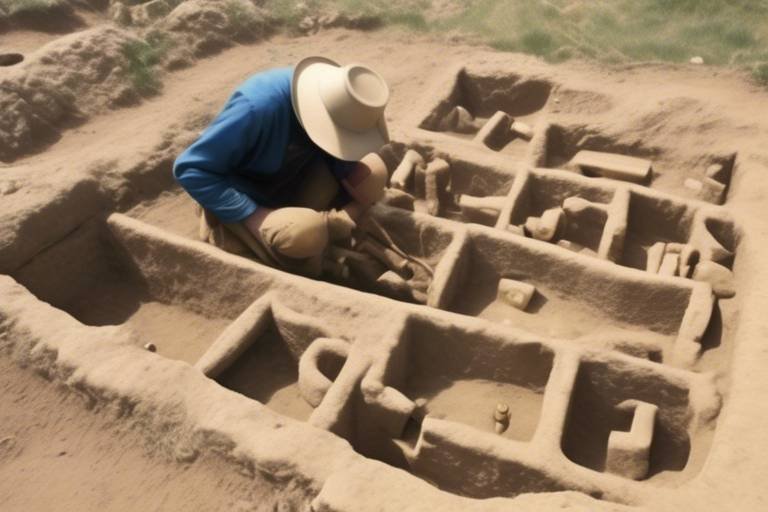The Influence of Ancient Sumerian Culture
Ancient Sumerian culture holds a profound influence on various aspects of modern society, ranging from language and religion to architecture. The legacy of this civilization continues to shape our world in ways we may not even realize. The Sumerians, with their innovative contributions, have left an indelible mark on human history that resonates through the ages.

Language and Writing Systems
Exploring the impact of Ancient Sumerian civilization on modern society, language, religion, and architecture. Discover how this ancient culture laid the foundation for many aspects of today's world.
Investigating the development of cuneiform script and its influence on modern writing systems. Explore how Sumerian language elements have persisted in various languages worldwide.
The Sumerians are credited with the development of one of the earliest writing systems known as cuneiform. This intricate script, consisting of wedge-shaped characters impressed on clay tablets, revolutionized communication in the ancient world. The influence of cuneiform can be seen in the evolution of writing systems across different cultures, showcasing the enduring legacy of Sumerian language and writing.
Furthermore, the Sumerian language itself has left a lasting imprint on linguistic diversity. Elements of Sumerian vocabulary and grammar have permeated various languages, demonstrating the profound impact of this ancient civilization on the linguistic landscape of today.
In addition to their written language, the Sumerians also developed a system of numerical notation, contributing to the advancement of mathematical concepts. This numerical system laid the groundwork for future mathematical innovations and continues to influence numerical representations in modern society.
Through the exploration of Sumerian language and writing systems, we gain insight into the sophisticated intellectual achievements of this ancient culture and their enduring influence on contemporary communication and knowledge systems.

Religious Beliefs and Practices
Exploring the impact of Ancient Sumerian civilization on modern society, language, religion, and architecture. Discover how this ancient culture laid the foundation for many aspects of today's world.
Religion held a central place in Ancient Sumerian society, shaping their worldview and daily practices. The Sumerians believed in a complex pantheon of gods and goddesses, each associated with different aspects of life and nature. Their religious beliefs influenced various rituals, ceremonies, and social structures, reflecting a deep connection between the spiritual and earthly realms.
The concept of divinity in Sumerian culture was multifaceted, with gods embodying both benevolent and wrathful qualities. Deities like Anu, Enlil, and Inanna played significant roles in the Sumerian religious pantheon, overseeing domains such as the sky, earth, and fertility. The practice of offering sacrifices and prayers to these gods was a common feature of Sumerian religious life, aiming to seek favor, protection, and divine guidance.
Moreover, the Sumerians believed in an afterlife, where the souls of the deceased journeyed to the underworld ruled by the goddess Ereshkigal. This belief in the continuation of existence beyond death influenced funerary practices, including burial customs and rituals meant to ensure a smooth transition to the afterlife.
The religious practices of the Sumerians laid the groundwork for future civilizations, influencing the development of Mesopotamian religions and later monotheistic faiths. The legacy of Sumerian religious beliefs can be seen in the mythological motifs, symbols, and moral values that have endured through centuries, resonating in modern spirituality and religious traditions.

Architectural Innovations
Architectural innovations of the Ancient Sumerians stand as a testament to their advanced civilization. Among their most notable contributions are the majestic ziggurats, towering temple structures that served as focal points of religious and social life. These stepped pyramids, with their intricate terraces and staircases, showcased the Sumerians' mastery of construction and engineering. The ziggurats not only symbolized the connection between heaven and earth but also demonstrated the Sumerians' devotion to their deities.
Furthermore, the Sumerians were pioneers in urban planning, developing sophisticated city layouts with well-defined streets, public buildings, and residential areas. Their cities, such as Uruk and Ur, featured intricate irrigation systems that supported agriculture and facilitated trade. The Sumerians' emphasis on efficient city organization and infrastructure laid the groundwork for future urban development and influenced architectural practices for centuries to come.
In addition to monumental structures like ziggurats, the Sumerians excelled in the construction of palaces and fortifications. These buildings showcased intricate decorative elements and advanced masonry techniques, highlighting the Sumerians' craftsmanship and artistic sensibilities. The use of mud bricks and baked bricks in their buildings not only provided durability but also allowed for intricate designs and reliefs to adorn the walls, depicting scenes from daily life, mythology, and religious rituals.
The Sumerians' architectural innovations were not only functional but also symbolic, reflecting their societal values and religious beliefs. The careful planning and construction of their buildings served as a physical manifestation of their cultural identity and spiritual devotion. The legacy of Sumerian architecture can be seen in the monumental structures of later civilizations, with echoes of their design principles and aesthetic sensibilities reverberating through the annals of architectural history.

Trade and Economics
Trade and Economics in Ancient Sumer were fundamental aspects of their society, shaping not only their economy but also influencing trade practices globally. The Sumerians were pioneers in establishing trade networks, connecting various regions and facilitating the exchange of goods and services. Their strategic location between major civilizations allowed them to become a hub for commerce, fostering economic growth and cultural exchange.
One of the key contributions of Sumerian trade was the development of early forms of currency, such as barley and silver, which streamlined transactions and standardized value. This innovation laid the groundwork for modern monetary systems and paved the way for the evolution of trade practices. Additionally, the Sumerians' emphasis on trade routes and economic partnerships set a precedent for future civilizations, influencing the development of international trade relations.
Moreover, the Sumerians' expertise in agriculture played a significant role in their economic prosperity. By implementing advanced irrigation techniques and efficient crop cultivation methods, they were able to sustain a surplus of agricultural produce, which they traded with neighboring regions. This agricultural surplus not only fueled their economy but also contributed to the overall stability and growth of their society.
The economic success of Ancient Sumer can also be attributed to their sophisticated accounting practices and record-keeping systems. Sumerian merchants meticulously documented transactions, inventories, and trade agreements, laying the foundation for modern accounting principles. These early financial records not only ensured transparency and accountability in business dealings but also facilitated long-term economic planning and investment.
Furthermore, the Sumerians' emphasis on fair trade practices and contractual agreements established a sense of trust and reliability in their commercial interactions. This commitment to ethical business conduct set a precedent for future trade relationships and contributed to the longevity of their economic influence. The principles of honesty, integrity, and mutual benefit that guided Sumerian trade transactions continue to resonate in contemporary business practices.

Legal Systems and Governance
Legal Systems and Governance in Ancient Sumer were remarkably advanced for their time, setting a precedent for legal practices that would influence societies for centuries to come. The most famous legal code, the Code of Ur-Nammu, dating back to around 2100 BC, is one of the earliest known examples of written laws. This code provided guidelines for various aspects of life, including family matters, property rights, and criminal offenses. It established principles of justice and fairness, emphasizing the importance of accountability and restitution.
One of the key features of Sumerian legal systems was the concept of retribution, where punishments were often based on the principle of "an eye for an eye." This system aimed to maintain order in society by ensuring that individuals faced consequences for their actions. Additionally, the legal codes outlined specific penalties for different offenses, ensuring a degree of consistency and predictability in the administration of justice.
Moreover, the Sumerians had a well-defined judicial system with judges and courts responsible for interpreting and enforcing the laws. These legal authorities played a crucial role in resolving disputes, settling conflicts, and upholding the rule of law within the community. The presence of legal institutions helped maintain social order and stability, fostering a sense of security and trust among the populace.
Furthermore, the legal principles of Ancient Sumer laid the groundwork for many fundamental concepts of governance and jurisprudence that continue to shape legal systems worldwide. The emphasis on written laws, judicial procedures, and the protection of individual rights reflected a sophisticated understanding of legal principles and ethics. The legacy of Sumerian legal systems can be seen in the development of modern legal frameworks, emphasizing the importance of justice, equity, and the rule of law in society.

Art and Craftsmanship
The of the Ancient Sumerians is a testament to their creativity and skill that continues to captivate us today. Their artistic achievements in sculpture, pottery, and jewelry showcase a level of craftsmanship that was truly ahead of its time. The intricate designs and techniques employed by Sumerian artisans have left a lasting legacy, inspiring generations of artists and craftsmen.
Sumerian sculpture, characterized by its detailed and expressive forms, often depicted scenes from daily life, mythology, and religious beliefs. The craftsmanship exhibited in these sculptures, whether in stone or clay, reveals a deep understanding of anatomy and storytelling. Each piece tells a story, capturing moments of triumph, worship, or everyday activities with remarkable precision.
In the realm of pottery, the Sumerians were pioneers in developing sophisticated techniques for creating vessels and containers. Their pottery was not only utilitarian but also served as a canvas for intricate designs and motifs. The use of symbols and patterns in Sumerian pottery added layers of meaning, reflecting their cultural beliefs and aesthetic sensibilities.
When it comes to jewelry, the Sumerians were known for their exquisite craftsmanship and use of precious materials such as gold, silver, and gemstones. Their jewelry designs ranged from simple adornments to intricate pieces featuring symbolic motifs and religious iconography. Sumerian jewelry was not just decorative but also held symbolic significance, often representing status, protection, or spiritual beliefs.
One of the remarkable aspects of Sumerian artistry is the integration of art into everyday life. Whether through sculptures adorning temples, pottery used in daily rituals, or jewelry worn as symbols of identity, art permeated every aspect of Sumerian society. The attention to detail and artistic expression displayed in their craftsmanship reflect a culture that valued beauty, creativity, and storytelling.

Agricultural Practices
When it comes to the agricultural practices of the Ancient Sumerians, one cannot overlook their innovative techniques that revolutionized food production. The Sumerians were among the first to develop sophisticated irrigation systems to support their crops, allowing for efficient cultivation in the arid Mesopotamian region. These early farmers constructed canals and ditches to divert water from the Tigris and Euphrates rivers, ensuring a steady water supply for their fields.
In addition to their advanced irrigation methods, the Sumerians also engaged in crop rotation to maintain soil fertility and maximize yields. By alternating the types of crops planted in specific fields each season, they prevented soil depletion and ensured sustainable agriculture. This practice not only increased productivity but also contributed to the long-term viability of their agricultural endeavors.
Furthermore, the Sumerians were pioneers in the domestication of livestock, including sheep, goats, and cattle. They utilized these animals not only for food but also for labor, such as plowing fields and transporting goods. This integration of livestock into their agricultural practices enhanced efficiency and diversified their food sources, laying the groundwork for future advancements in animal husbandry.
Moreover, the Sumerians excelled in the cultivation of various crops, including barley, wheat, dates, and vegetables. Their agricultural surplus not only sustained their growing population but also enabled trade with neighboring regions, fostering economic development and cultural exchange. The abundance of agricultural products facilitated the growth of urban centers and the establishment of specialized craftsmen and merchants within Sumerian society.

Social Structure and Daily Life
Ancient Sumerian society was structured in a hierarchical manner, with distinct social classes determining one's place in the community. At the top of the societal pyramid were the rulers and priests, who held significant power and influence over the population. These elite members of society oversaw religious ceremonies, governance, and decision-making processes that impacted the entire community. Beneath them were the wealthy merchants and landowners, who enjoyed a comfortable lifestyle due to their economic prosperity and connections with the ruling class.
Further down the social ladder were the artisans and craftsmen, skilled individuals responsible for creating the intricate artwork and tools that defined Sumerian culture. These craftsmen played a vital role in shaping the aesthetic and functional aspects of daily life, contributing to the overall prosperity and cultural richness of the society. Additionally, farmers and laborers formed the foundation of Sumerian economy, working the land and producing essential goods to sustain the population.
Family structure was central to Sumerian society, with households typically consisting of extended family members living together in close proximity. Family ties were strong, and kinship relationships played a crucial role in social interactions and support systems. Women held respected positions within the household, managing domestic affairs and childcare responsibilities while also engaging in economic activities such as textile production and trade.
Everyday life in Ancient Sumer revolved around a combination of work, religious rituals, and communal activities. The Sumerians placed great importance on education, with scribal schools training individuals in the art of writing and record-keeping. Religious ceremonies and festivals were integral to the social fabric, providing opportunities for community bonding and spiritual expression. Trade and bartering were common practices, facilitating the exchange of goods and resources among different social groups.
Overall, the social structure of Ancient Sumerian society was complex and multi-faceted, reflecting the diverse roles and responsibilities of its members. From rulers and priests to artisans and laborers, each individual contributed to the functioning of the community and the preservation of cultural traditions that continue to influence modern societies today.
Frequently Asked Questions
- What is the significance of Ancient Sumerian culture?
Ancient Sumerian culture holds great significance as it laid the foundation for various aspects of modern society. From language and writing systems to religious beliefs, architecture, trade, and legal systems, the influence of the Sumerians can be seen in many facets of contemporary life.
- How did Sumerian language impact modern writing systems?
The development of cuneiform script by the Sumerians had a profound impact on modern writing systems. Elements of the Sumerian language have persisted in various languages worldwide, showcasing the enduring legacy of their linguistic innovations.
- What were the religious beliefs of the Sumerians?
The Sumerians had a rich pantheon of deities and intricate religious practices that influenced subsequent religions. Exploring their beliefs offers insights into the origins of many spiritual concepts still prevalent in contemporary society.
- How did Sumerian architectural innovations shape history?
The architectural achievements of the Sumerians, including ziggurats and city planning, have had a lasting impact on architectural practices. Their early structures paved the way for future developments in construction and urban design.
- What were the key aspects of Sumerian trade and economics?
By analyzing the economic systems and trade networks of Ancient Sumer, one can understand how their commerce influenced the development of trade routes and economic principles still relevant today. The Sumerians played a crucial role in shaping early trade practices.
- How did Sumerian legal systems influence modern concepts of justice?
Exploring the legal codes of Sumer, particularly the Code of Ur-Nammu, provides insights into the origins of modern legal practices. The early legal systems of the Sumerians have had a lasting impact on the concepts of justice and governance.



















